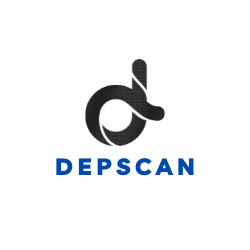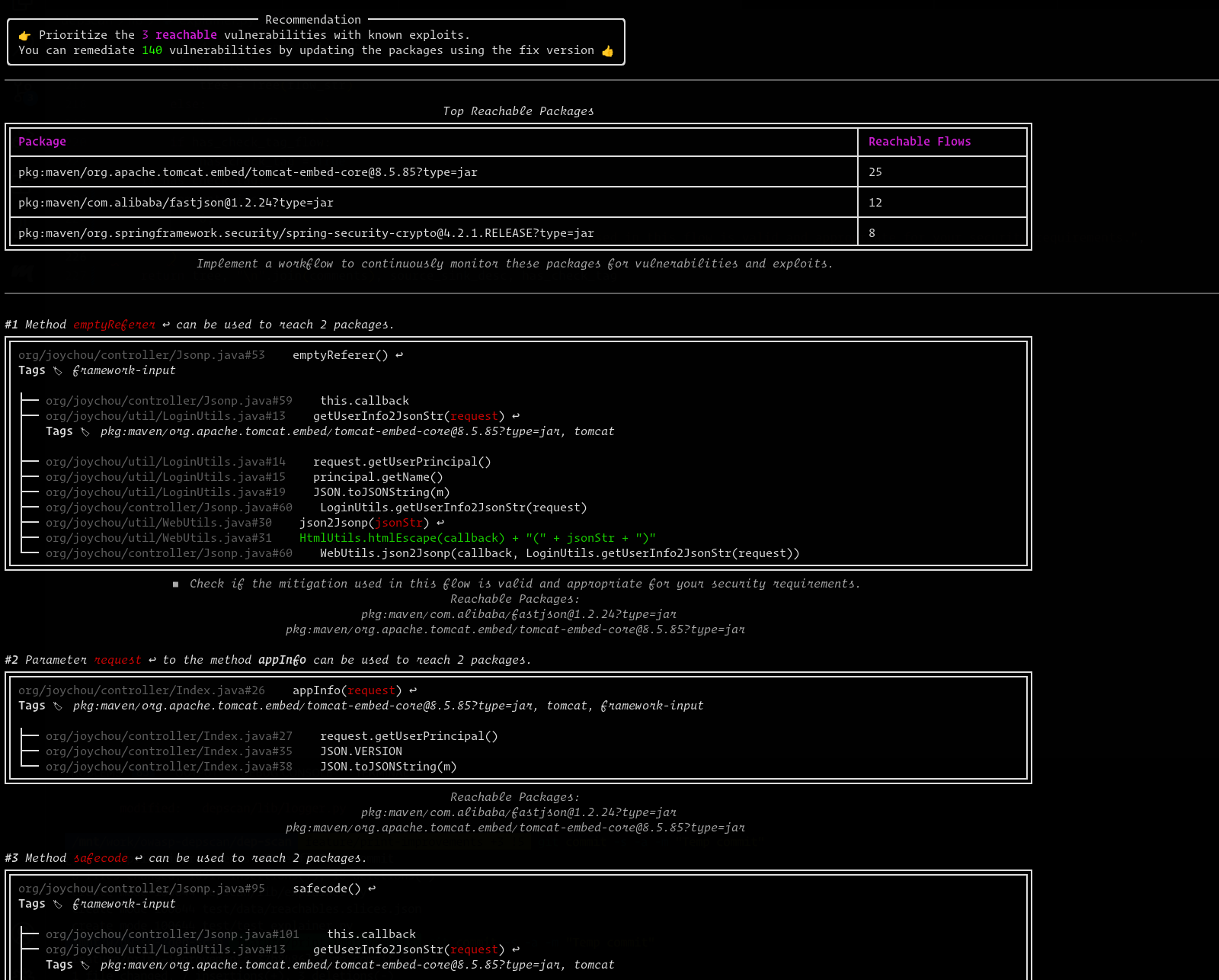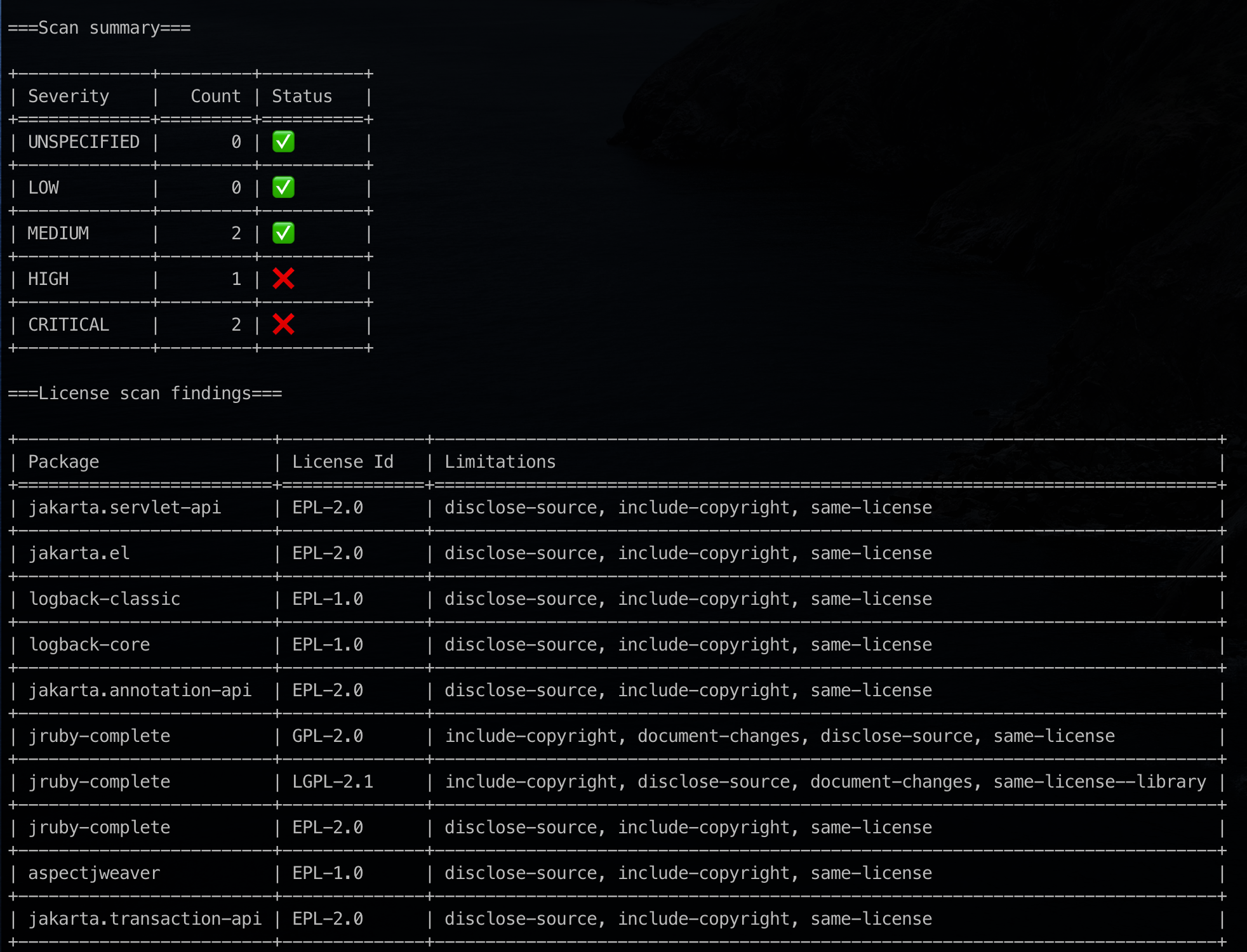OWASP dep-scan
Introduction
OWASP dep-scan is a next-generation security and risk audit tool based on known vulnerabilities, advisories, and license limitations for project dependencies. Both local repositories and container images are supported as the input, and the tool is ideal for integration with ASPM/VM platforms and in CI environments.

Features
- Scan most application code - local repos, Linux container images, Kubernetes manifests, and OS - to identify known CVEs with prioritization
- Perform advanced reachability analysis for multiple languages (See reachability analysis)
- Package vulnerability scanning is performed locally and is quite fast. No server is used!
- Generate Software Bill-of-Materials (SBOM) with Vulnerability Disclosure Report (VDR) information
- Generate a Common Security Advisory Framework (CSAF) 2.0 VEX document (check out the CSAF Readme)
- Perform deep packages risk audit for dependency confusion attacks and maintenance risks (See risk audit)


Vulnerability Data sources
- OSV
- NVD
- GitHub
- NPM
- Linux vuln-list (Use
--cache-os)
Linux distros
- AlmaLinux
- Debian
- Alpine
- Amazon Linux
- Arch Linux
- RHEL/CentOS
- Rocky Linux
- Ubuntu
- OpenSUSE/SLES
- Photon
- Chainguard
- Wolfi OS
Application vulnerabilities would be reported for all Linux distros and Windows. To download the full vulnerability database suitable for scanning OS, invoke dep-scan with --cache-os for the first time. dep-scan would also download the appropriate database based on project type automatically.
Usage
dep-scan is ideal for use during continuous integration (CI) and as a local development tool.
OCI Artifacts via ORAS cli
Use ORAS cli to download the dep-scan binary and the vulnerability database for effortless integration. Example workflow is here.
export VDB_HOME=depscan
mkdir -p $VDB_HOME
oras pull ghcr.io/appthreat/vdb:v5 -o $VDB_HOME
oras pull ghcr.io/appthreat/depscan:v4 -o $VDB_HOME
Server mode
dep-scan and cdxgen could be run in server mode. Use the included docker compose file to get started.
git clone https://github.com/owasp-dep-scan/dep-scan
docker compose up
depscan --server --server-host 0.0.0.0 --server-port 7070
In server mode, use /cache endpoint to cache the vulnerability database.
# This would take over 5 minutes
curl http://0.0.0.0:7070/cache
Use the /scan endpoint to perform scans.
[!NOTE] The
typeparameter is mandatory in server mode.
- Scanning a local directory.
curl --json '{"path": "/tmp/vulnerable-aws-koa-app", "type": "js"}' http://0.0.0.0:7070/scan - Scanning an SBOM file (present locally).
curl --json '{"path": "/tmp/vulnerable-aws-koa-app/sbom_file.json", "type": "js"}' http://0.0.0.0:7070/scan - Scanning a GitHub repo.
curl --json '{"url": "https://github.com/HooliCorp/vulnerable-aws-koa-app", "type": "js"}' http://0.0.0.0:7070/scan -o app.vdr.json - Uploading an SBOM file and generating results based on it.
curl -X POST -H 'Content-Type: multipart/form-data' -F 'file=@/tmp/app/sbom_file.json' http://0.0.0.0:7070/scan?type=js
Scanning projects locally (Python version)
sudo npm install -g @cyclonedx/cdxgen
pip install owasp-depscan
This would install two commands called cdxgen and depscan.
You can invoke the scan command directly with the various options.
cd <project to scan>
depscan --src $PWD --reports-dir $PWD/reports
The full list of options is below:
usage: cli.py [-h] [--no-banner] [--cache] [--csaf] [--sync] [--profile {appsec,research,operational,threat-modeling,license-compliance,generic}] [--no-suggest] [--risk-audit] [--private-ns PRIVATE_NS] [-t PROJECT_TYPE] [--bom BOM] [-i SRC_DIR_IMAGE] [-o REPORT_FILE]
[--reports-dir REPORTS_DIR] [--deep] [--no-universal] [--no-vuln-table] [--threatdb-server THREATDB_SERVER] [--threatdb-username THREATDB_USERNAME] [--threatdb-password THREATDB_PASSWORD] [--threatdb-token THREATDB_TOKEN] [--server]
[--server-host SERVER_HOST] [--server-port SERVER_PORT] [--cdxgen-server CDXGEN_SERVER] [--debug] [--explain] [--reachables-slices-file REACHABLES_SLICES_FILE] [-v]
Fully open-source security and license audit for application dependencies and container images based on known vulnerabilities and advisories.
options:
-h, --help show this help message and exit
--no-banner Do not display banner
--cache Cache vulnerability information in platform specific user_data_dir
--csaf Generate a OASIS CSAF VEX document
--sync Sync to receive the latest vulnerability data. Should have invoked cache first.
--profile {appsec,research,operational,threat-modeling,license-compliance,generic}
Profile to use while generating the BOM.
--no-suggest Disable suggest mode
--risk-audit Perform package risk audit (slow operation). Npm only.
--private-ns PRIVATE_NS
Private namespace to use while performing oss risk audit. Private packages should not be available in public registries by default. Comma separated values accepted.
-t PROJECT_TYPE, --type PROJECT_TYPE
Override project type if auto-detection is incorrect
--bom BOM Examine using the given Software Bill-of-Materials (SBOM) file in CycloneDX format. Use cdxgen command to produce one.
-i SRC_DIR_IMAGE, --src SRC_DIR_IMAGE
Source directory or container image or binary file
-o REPORT_FILE, --report_file REPORT_FILE
DEPRECATED. Use reports directory since multiple files are created. Report filename with directory
--reports-dir REPORTS_DIR
Reports directory
--deep Perform deep scan by passing this --deep argument to cdxgen. Useful while scanning docker images and OS packages.
--no-universal Depscan would attempt to perform a single universal scan instead of individual scans per language type.
--no-vuln-table Do not print the table with the full list of vulnerabilities. This can help reduce console output.
--threatdb-server THREATDB_SERVER
ThreatDB server url. Eg: https://api.sbom.cx
--threatdb-username THREATDB_USERNAME
ThreatDB username
--threatdb-password THREATDB_PASSWORD
ThreatDB password
--threatdb-token THREATDB_TOKEN
ThreatDB token for token based submission
--server Run depscan as a server
--server-host SERVER_HOST
depscan server host
--server-port SERVER_PORT
depscan server port
--cdxgen-server CDXGEN_SERVER
cdxgen server url. Eg: http://cdxgen:9090
--debug Run depscan in debug mode.
--explain Makes depscan to explain the various analysis. Useful for creating detailed reports.
--reachables-slices-file REACHABLES_SLICES_FILE
Path for the reachables slices file created by atom.
-v, --version Display the version
Scanning containers locally (Python version)
Scan latest tag of the container shiftleft/scan-slim
depscan --cache --src shiftleft/scan-slim -o containertests/depscan-scan.json -t docker
Include license to the type to perform license audit.
depscan --cache --src shiftleft/scan-slim -o containertests/depscan-scan.json -t docker,license
You can also specify the image using the sha256 digest
depscan --src redmine@sha256:a5c5f8a64a0d9a436a0a6941bc3fb156be0c89996add834fe33b66ebeed2439e -o containertests/depscan-redmine.json -t docker
You can also save container images using docker or podman save command and pass the archive to depscan for scanning.
docker save -o /tmp/scanslim.tar shiftleft/scan-slim:latest
# podman save --format oci-archive -o /tmp/scanslim.tar shiftleft/scan-slim:latest
depscan --src /tmp/scanslim.tar -o reports/depscan-scan.json -t docker
Refer to the docker tests under GitHub action workflow for this repo for more examples.
Scanning projects locally (Docker container)
ghcr.io/appthreat/dep-scan or public.ecr.aws/appthreat/dep-scan:latest container image can be used to perform the scan.
To scan with default settings
docker run --rm -v $PWD:/app ghcr.io/appthreat/dep-scan --src /app --reports-dir /app/reports
Using AWS public ECR image
docker run --rm -v $PWD:/app public.ecr.aws/appthreat/dep-scan --src /app --reports-dir /app/reports
To scan with custom environment variables based configuration
docker run --rm \
-e VDB_HOME=/db \
-e NVD_START_YEAR=2010 \
-e GITHUB_PAGE_COUNT=5 \
-e GITHUB_TOKEN=<token> \
-v /tmp:/db \
-v $PWD:/app ghcr.io/appthreat/dep-scan --src /app --reports-dir /app/reports
In the above example, /tmp is mounted as /db into the container. This directory is then specified as VDB_HOME for caching the vulnerability information. This way the database can be cached and reused to improve performance.
Supported languages and package format
dep-scan uses cdxgen command internally to create Software Bill-of-Materials (SBoM) file for the project. This is then used for performing the scans.
The following projects and package-dependency format is supported by cdxgen.
| Language | Package format |
|---|---|
| node.js | package-lock.json, pnpm-lock.yaml, yarn.lock, rush.js, bower.json, .min.js |
| java | maven (pom.xml [1]), gradle (build.gradle, .kts), scala (sbt), bazel |
| php | composer.lock |
| python | setup.py, requirements.txt [2], Pipfile.lock, poetry.lock, bdist_wheel, .whl, .egg-info |
| go | binary, go.mod, go.sum, Gopkg.lock |
| ruby | Gemfile.lock, gemspec |
| rust | binary, Cargo.toml, Cargo.lock |
| .Net | .csproj, packages.config, project.assets.json [3], packages.lock.json, .nupkg |
| dart | pubspec.lock, pubspec.yaml |
| haskell | cabal.project.freeze |
| elixir | mix.lock |
| c/c++ | conan.lock, conanfile.txt |
| clojure | Clojure CLI (deps.edn), Leiningen (project.clj) |
| docker / oci image | All supported languages and Linux OS packages |
| GitHub Actions Workflows | .github/workflows/*.yml |
| Jenkins Plugins | .hpi files |
| YAML manifests | docker-compose, kubernetes, kustomization, skaffold, tekton etc |
NOTE
The docker image for dep-scan currently doesn’t bundle suitable java and maven commands required for bom generation. To workaround this limitation, you can -
- Use python-based execution from a VM containing the correct versions for java, maven and gradle.
- Generate the bom file by invoking
cdxgencommand locally and subsequently passing this todep-scanvia the--bomargument.
Reachability analysis
Depscan can perform reachability analysis for Java, JavaScript, TypeScript and Python with built-in support for parsing atom reachables slicing. Simply invoke depscan with the research profile and language type to enable this feature.
To receive a verbose output including the reachable flows, pass the argument --explain
--profile research -t language [--explain]
Example analysis for a Java project
depscan --profile research -t java -i <source directory> --reports-dir <reports directory> --explain
Example analysis for a JavaScript project
depscan --profile research -t js -i <source directory> --reports-dir <reports directory> --explain
Customization through environment variables
The following environment variables can be used to customise the behaviour.
- VDB_HOME - Directory to use for caching database. For docker based execution, this directory should get mounted as a volume from the host
- NVD_START_YEAR - Default: 2018. Supports upto 2002
- GITHUB_PAGE_COUNT - Default: 2. Supports upto 20
GitHub Security Advisory
To download security advisories from GitHub, a personal access token with the following scope is necessary.
- read:packages
export GITHUB_TOKEN="<PAT token>"
Suggest mode
Fix version for each vulnerability is retrieved from the sources. Sometimes, there might be known vulnerabilities in the fix version reported. Eg: in the below screenshot the fix versions suggested for jackson-databind might contain known vulnerabilities.

By passing an argument --suggest it is possible to force depscan to recheck the fix suggestions. This way the suggestion becomes more optimal for a given package group.

Notice, how the new suggested version is 2.9.10.5 which is an optimal fix version. Please note that the optimal fix version may not be the appropriate version for your application based on compatibility.
Package Risk audit
--risk-audit argument enables package risk audit. Currently, only npm and pypi packages are supported in this mode. A number of risk factors are identified and assigned weights to compute a final risk score. Packages that then exceed a maximum risk score (config.pkg_max_risk_score) are presented in a table.
Use --private-ns to specify the private package namespace that should be checked for dependency confusion type issues where a private package is available on public npm/pypi registry.
For example, to check if private packages with namespaces @appthreat and @shiftleft are not accidentally made public, use the below argument.
--private-ns appthreat,shiftleft
| Risk category | Default Weight | Reason |
|---|---|---|
| pkg_private_on_public_registry | 4 | Private package is available on a public registry |
| pkg_min_versions | 2 | Packages with less than 3 versions represent an extreme where they could be either super stable or quite recent. Special heuristics are applied to ignore older stable packages |
| mod_create_min_seconds | 1 | Less than 12 hours difference between modified and creation time. This indicates that the upload had a defect that had to be rectified immediately. Sometimes, such a rapid update could also be malicious |
| latest_now_min_seconds | 0.5 | Less than 12 hours difference between the latest version and the current time. Depending on the package such a latest version may or may not be desirable |
| latest_now_max_seconds | 0.5 | Package versions that are over 6 years old are in use. Such packages might have vulnerable dependencies that are known or yet to be found |
| pkg_min_maintainers | 2 | Package has less than 2 maintainers. Many opensource projects have only 1 or 2 maintainers so special heuristics are used to ignore older stable packages |
| pkg_min_users | 0.25 | Package has less than 2 npm users |
| pkg_install_scripts | 2 | Package runs a custom pre or post installation scripts. This is often malicious and a downside of npm. |
| pkg_node_version | 0.5 | Package supports outdated version of node such as 0.8, 0.10, 4 or 6.x. Such projects might have prototype pollution or closure related vulnerabilities |
| pkg_scope | 4 or 0.5 | Packages that are used directly in the application (required scope) gets a score with a weight of 4. Optional packages get a score of 0.25 |
| deprecated | 1 | Latest version is deprecated |
Refer to pkg_query.py::get_category_score method for the risk formula.
Automatic adjustment
A parameter called created_now_quarantine_seconds is used to identify packages that are safely past the quarantine period (1 year). Certain risks such as pkg_min_versions and pkg_min_maintainers are suppressed for packages past the quarantine period. This adjustment helps reduce noise since it is unlikely that a malicious package can exist in a registry unnoticed for over a year.
Configuring weights
All parameters can be customized by using environment variables. For eg:
export PKG_MIN_VERSIONS=4 to increase and set the minimum versions category to 4.
Live OS scan
By passing -t os, depscan can generate an SBoM for a live operating system or a VM with OS packages and kernel information. Optionally, pass the argument --deep to generate an SBoM with both OS and application packages and to check for application vulnerabilities.
All OS packages.
depscan -t os -i . -o reports/depscan.json
All OS and application packages.
depscan -t os --deep -i . -o reports/depscan.json
License scan
dep-scan can scan the dependencies for any license limitations and report them directly on the console log. To enable license scanning set the environment variable FETCH_LICENSE to true.
export FETCH_LICENSE=true
The license data is sourced from choosealicense.com and is quite limited. If the license of a given package cannot be reliably matched against this list it will get silently ignored to reduce any noise. This behavior could change in the future once the detection logic gets improved.

Kubernetes and Cloud apps
dep-scan could auto-detect most cloud applications and Kubernetes manifest files. Pass the argument -t yaml-manifest to manually specify the type.
PDF reports
Ensure wkhtmltopdf is installed or use the official container image to generate pdf reports. Use with --explain for more detailed reports.
Discord support
The developers could be reached via the discord channel.
Media









